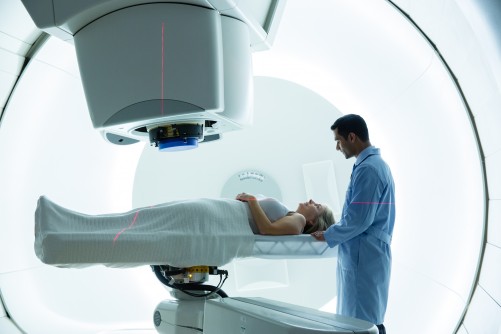Scientists to Study How Best to Advance Different Types of Radiation Therapy
 Physicists in the Radiation Detector and Imaging group and associated with the Biomedical Research & Innovation Center (BRIC) at the US Department of Energy’s Thomas Jefferson National Accelerator Facility have been for several years pursuing radiation therapy technology improvements in collaboration with the Hampton University Proton Cancer Institute (HUPCI). Now, BRIC physicists are launching a study into how best to advance different types of radiation therapy.
Physicists in the Radiation Detector and Imaging group and associated with the Biomedical Research & Innovation Center (BRIC) at the US Department of Energy’s Thomas Jefferson National Accelerator Facility have been for several years pursuing radiation therapy technology improvements in collaboration with the Hampton University Proton Cancer Institute (HUPCI). Now, BRIC physicists are launching a study into how best to advance different types of radiation therapy.
BRIC scientists plan to evaluate the ability of accelerator-based proton therapy, like that offered locally by HUPCI, to replace treatments using radioactive sources, such as cobalt-60, to reduce potential radiological risks that could be associated with such isotopes.
Helming the study is Cameron Clarke, a Jefferson Lab staff scientist who developed the proposal in conjunction with colleagues Michael Dion and Eric Christy.
“As an early-career scientist who has just joined the lab as a staff member working explicitly to further the BRIC initiative, I am very excited to have received this green light from the DOE,” Clarke said. “I am also excited about how the genesis of this project reflects the effectiveness of the labwide collaborative approach that BRIC is aiming to facilitate, and I can’t wait to continue to pursue those connections as I dive into the study.”
Scientists in BRIC collaborate with private- and public-sector partners to assist with the development of new devices and systems which apply the lab’s knowledge of, and decades of world-class expertise with, particle accelerators and detectors.
Among Jefferson Lab's BRIC-related innovations are advanced nuclear medicine imaging devices to better detect cancer; using electron beams for water treatment; and developing radiation imaging detectors for plant biology research to help find ways to optimize plant productivity, biofuel development and carbon sequestration in biomass.
The new study is funded by the DOE National Nuclear Security Administration’s Office of Radiological Security (ORS) and will run through fiscal year 2025. ORS focuses on global radiological security and promotes alternative technologies to reduce the use of radioactive source-based devices as a form of permanent risk reduction.
External beam radiotherapy is the use of external radiation to pass through the body and deposit energy to internal organs. It can be done using X-rays, gamma rays or subatomic particles such as electrons, neutrons or protons.
Proton therapy is the use of an external proton beam, much like the one at the DOE Office of Science user facility at Jefferson Lab, the Continuous Electron Beam Accelerator Facility, which is used to study the building blocks of matter using an electron beam.
Each method has its pros and cons.
Proton therapy, for instance, is difficult and expensive to implement, requiring a hospital or clinic to build a particle accelerator, radiation shielding and large rotating gantries to enable multiple angles of treatment.
Radiotherapy using radioisotope sources, meanwhile, needs only a clinical room-size apparatus to house the hot source and shielding and collimators to focus the beam used in treatment.
But the key advantages of proton therapy are the engineered safety features that prevent the radiation source from causing radiological hazards, which come from localizing most of the energy deposition and enabling rapid radiation source powering on and off. The spatial localization is especially attractive for treatment of cancerous tumors near sensitive tissues, such as for prostate and brain cancers, as well as for pediatric care, and the engineered radiation source control is attractive for radiological safety concerns.
Clarke and his colleagues will survey current state-of-the-art technologies and practical barriers to replacing radioisotope-based radiotherapy in collaboration with HUPCI and other clinical sites. They will also procure a proton therapy-capable computer treatment planning system and simulate the relative cancer treatment performance capabilities to use in discussions with medical practitioners and help bridge the gap between nuclear physics researchers and medical treatment professionals.